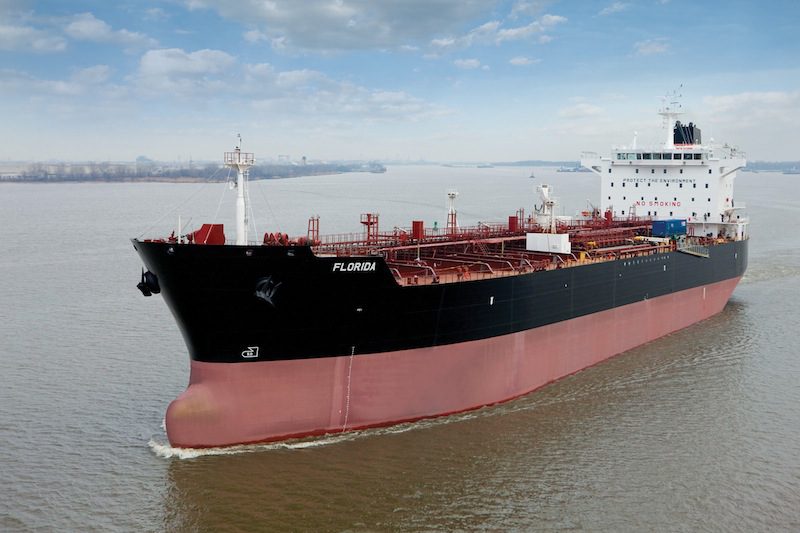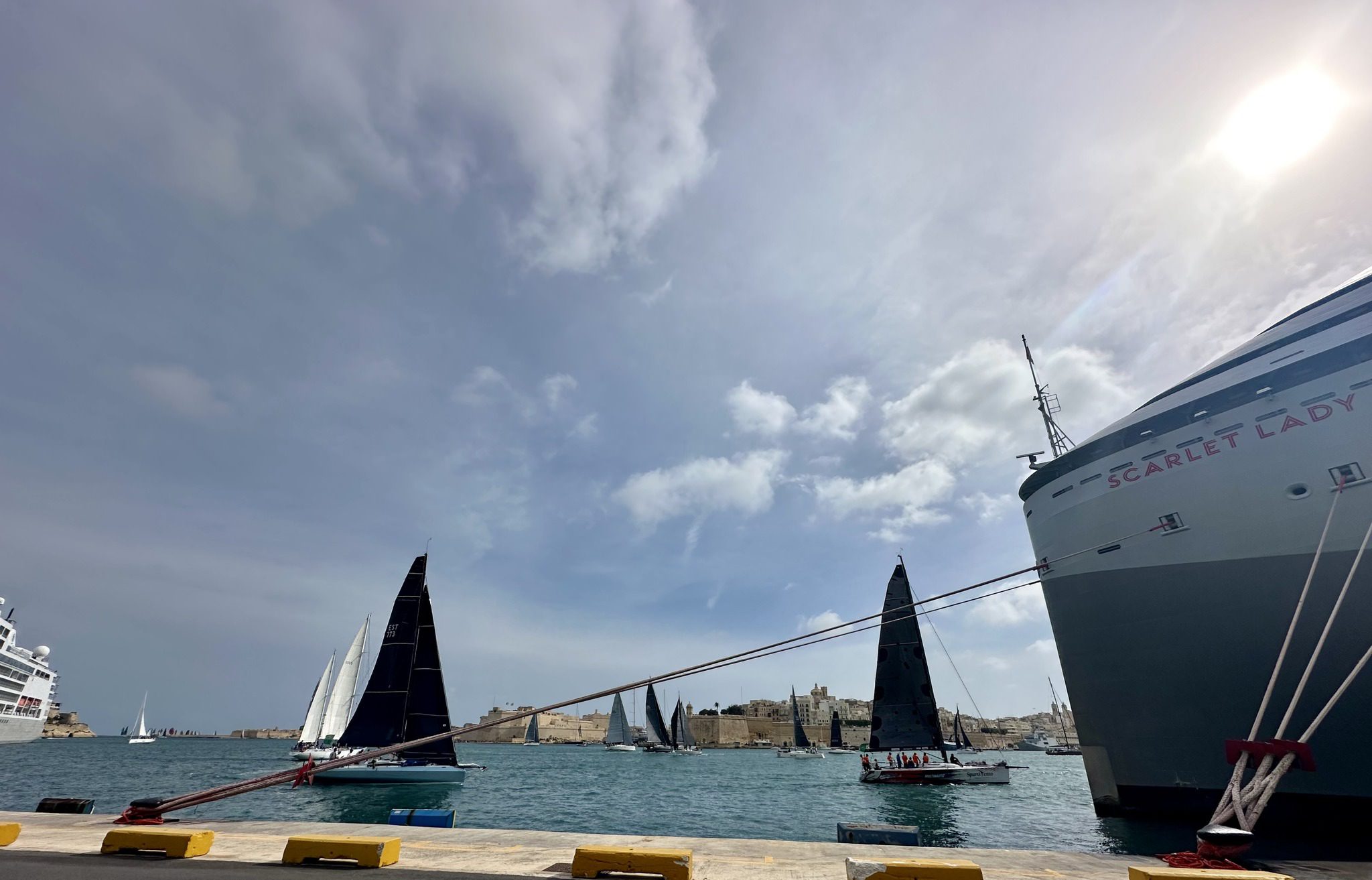M/T Florida, a 33,000 dwt Jones Act tanker. Image: Crowley
Oil tankers that move crude between U.S. ports are reaping windfall profits as domestic production surges and American laws prohibit exports.
Rates for Jones Act tankers, the only kind permitted to haul domestic fuel cargoes, jumped 87 percent to $85,978 a day in the past year, and the average cost will reach a record in 2013, according to Poten & Partners Inc., the New York-based maritime consultant. The largest owners include Overseas Shipholding Group Inc., which sought bankruptcy protection in November, and American Petroleum Tankers Parent LLC, a company controlled by Blackstone Group LP funds.
Extraction of oil from shale formations in the U.S. helped increase output to 6.2 million barrels a day in 2012, the most since 1998, cutting imports. That’s boosting coastal shipments as oil companies move crude to domestic refineries because the world’s second-largest energy-consuming nation prohibits exports of most crude. The Jones Act bars foreign ships from the trade.
“The increase in U.S. crude production is ultimately what’s driving the demand,” analyst Erik Nikolai Stavseth at investment bank Arctic Securities ASA, whose recommendations on shipping stocks returned 18 percent in the past year, said by phone from Oslo on Feb. 7. “The situation won’t change for as long as the law exists.”
Higher Rates
Rates for single-voyage charters averaged $98,947 a day so far this year, compared with an average of $55,947 through 2012, which was the highest in data stretching back to 2001, according to Poten. Almost all the ships are locked into long-term charters, so there are few available for additional cargoes, according to Jeff McGee, the head of marine research and consulting at Poten. The higher spot prices help owners to renew or negotiate better long-term contracts, according to Stavseth.
The output expansion is causing pipeline operators such as Calgary-based Enbridge Inc. to reverse the direction of oil conduits that once took international cargoes 500 miles inland. The switch will bring as much as 400,000 barrels a day of crude to the Gulf of Mexico, where more than 55 refineries are located, from Cushing, Oklahoma.
Domestic railroad shipments are also expanding. The first delivery of shale oil from the Bakken formation in the Midwest arrived this month at PBF Energy Inc.’s Delaware City refinery as rail capacity almost tripled to 110,000 barrels a day, the Parsippany, New Jersey-based company said in a statement Feb. 4. The company said it’s spending $50 million to double heavy-crude unloading capacity by the end of the year.
‘Healthy’ Flows
The increase in shale-oil supply is pushing up cargoes for Jones Act tankers between ports in the Gulf of Mexico, a trade that didn’t exist two years ago, Morten Arntzen, who resigned Feb. 11 as chief executive officer of New York-based Overseas Shipholding, said by phone four days earlier. His replacement Robert Johnston wasn’t available for an interview, Helen Harris, a spokeswoman for Overseas Shipholding, said by e-mail yesterday.
“It’s cash flow that matters, and we’re seeing very healthy cash flow generated by the Jones Act fleet,” Arntzen said. “Clearly the international crude markets are challenged. The demand for Jones Act tankers makes OSG a more appealing investment.”
The oil boom is having the reverse effect for Overseas Shipholding’s vessels operating globally because it’s driving down imports to the U.S. The company filed for bankruptcy protection on Nov. 14 amid the worst slump in global crude- shipping rates for more than a decade.
Owners are paying $17,963 a day toward fuel costs to bring Middle East crude to the U.S., the worst market since at least 1997, according to data from London-based Clarkson Plc, the world’s largest shipbroker. Companies sometimes pay part of fuel costs because the alternative is sailing empty and covering the entire expense, which can be as much as $60,000 a day.
Tax Issue
Overseas Shipholding listed assets of $4.15 billion and debt of $2.67 billion in its November filing in a Delaware bankruptcy court. Three weeks earlier, it said previous years’ financial statements couldn’t be relied upon and that it was exploring options including bankruptcy protection because of “a tax issue arising from the fact that the company is domiciled in the United States and has substantial international operations.”
Its fleet of 107 ships includes 22 Jones Act vessels, more than any other owner, according to Overseas Shipholding’s website and data compiled by Bloomberg. Ten are on long-term charters to the company. Seacor Holdings Inc., based in Fort Lauderdale, Florida, is the second-biggest with six of the tankers. American Petroleum has five, the same as Houston-based ConocoPhillips, according to the data compiled by Bloomberg.
‘Strong Year’
The rally will have less effect on Seacor or Blackstone than on Overseas Shipholding. American Petroleum had a $35.6 million net loss in 2011, according to the most recent regulatory filing on the Plymouth Meeting, Pennsylvania-based company’s website. That’s about 1.4 percent of the $2.52 billion in net income that Blackstone, the largest private-equity firm, will make this year, according to the median of 13 analyst estimates compiled by Bloomberg. Seacor had revenue of $1.45 billion for the first three quarters of 2012.
“It will be a very strong year,” American Petroleum CEO Robert Kurtz said by phone Feb. 7. “Demand is picking up and there’s a limited supply of vessels. Demand is driven by shale- oil production over the last six to 12 months.”
Overseas Shipholding stock rose 21 percent this year to $1.03 in New York trading, leading gains in the six-company Bloomberg Tanker Index, which added 8.9 percent. Shares of New York-based Blackstone climbed 17 percent to $18.30.
Lenders, Bondholders
Investors who purchase Overseas Shipholding stock are speculating the company’s lenders and bondholders will be paid back, leaving money for equity investors, said David Beard, an analyst at Iberia Capital Partners LLC in New Orleans, who has covered the maritime industry for about 15 years. He stopped following the tanker company after the bankruptcy.
Valuing the shipowner’s securities is impossible because of a lack of information about the size of Overseas Shipholding’s tax liability, combined with the fact that the U.S. could block the sale of its Jones Act fleet to an overseas buyer, he said.
Overseas Shipholding’s Jones Act fleet may continue to strengthen because of the expense of building new ships. A medium-range tanker with a capacity of 50,000 deadweight tons costs as much as $120 million to build domestically, three times more than by international constructors, according to a September presentation by New Canaan, Connecticut-based Moran Towing Corp., which owns and operates 95 tugs and barges, serving 16 ports.
“There are no spot ships available,” Poten’s McGee said by phone Feb. 5. “There aren’t even period ships available. It’s a very tight market because it’s supply-constrained, and there’s not much near-term opportunity for relief.”
– By Rob Sheridan and Isaac Arnsdorf, Copyright 2013 Bloomberg.
Unlock Exclusive Insights Today!
Join the gCaptain Club for curated content, insider opinions, and vibrant community discussions.

 Join The Club
Join The Club











